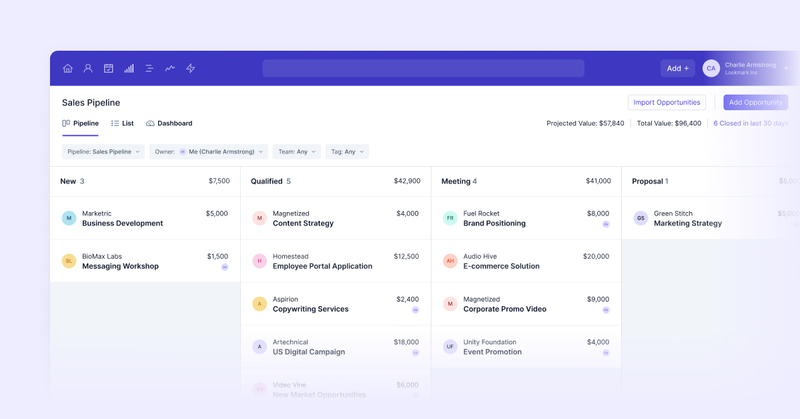If you’ve been in business for more than five minutes, you’ve likely heard how it costs much more to acquire new customers than to retain existing ones.
However, when it comes to increasing revenue, many businesses instinctively look for different ways to top up the sales funnel with more and more leads, while ignoring people who’ve already bought from them.
Your existing customer base holds a wealth of potential that’s just waiting to be uncovered. By mastering the art of cross-selling and upselling, you encourage current customers to purchase more or higher-value products to boost revenue.
In this article, we’ll look at different ways to use more cross-sell and upsell methods to increase revenue. We’ll also examine how you leverage your sales pipeline to use these strategies more efficiently.
Why cross-selling and upselling should be part of your sales process
Cross-selling and upselling are two of the most effective strategies for boosting revenue and increasing customer value in any business. Done correctly, both tactics improve customer satisfaction and loyalty by providing customers with additional value.
Cross-selling involves offering additional, complementary products or services — either at the point of purchase or afterward. The key to good cross-selling is relevance; the additional offerings must align with the customer’s original purchase or overall needs. For example, if a customer buys a new smartphone, you could suggest a protective case or an extended warranty plan. The goal is to increase the total purchase value while enhancing the customer’s experience by providing comprehensive solutions.
Similarly, upselling refers to encouraging customers to purchase a higher-end product than they are currently considering. Alternatively, you could offer additional features to their service that enhance its value. This strategy focuses on upgrading the customer's choice by highlighting the superior benefits of the higher-priced option. For example, in a SaaS model, this might mean showcasing the additional relevant features available on the premium plans
Both strategies are powerful tools for increasing the average order value (AOV), directly impacting the business’s bottom line. However, if these aren’t implemented properly, you could inadvertently overwhelm your customer.
Businesses must ensure that these strategies are executed in a way that genuinely benefits the recipient. By focusing on providing value and enhancing the customer experience, cross-selling and upselling can become powerful tools in any company’s revenue-enhancing arsenal.
How to improve your cross-selling and upselling strategies
Simply being aware of the possibilities for cross-selling and upselling will benefit your sales team. However, to get the best results, you’ll need thoughtful planning and execution. Here are three tactics to bear in mind:
Use customer data for personalized offers
Rather than relying on guesswork, use your customer data to create relevant offers. With a good customer relationship management (CRM) system, you can easily track individual preferences, purchase history and behavior patterns. You can then utilize analytics and reports to understand what cross-sell/upsell strategies are best at meeting those customer needs.
You can also use dedicated recommendation systems to boost your cross-selling efforts. These tools uncover buying patterns in your data, including those that aren’t immediately obvious to a casual observer, resulting in more intuitive recommendations that can significantly increase your AOV.
Make every interaction relevant
Cross-selling and upselling isn’t just about knowing what offers to make, but also when to make them. Find the best moments based on the customer’s interaction with your business. This could be during the checkout process, immediately after a service interaction or during a follow-up call.
Ensure your offers are contextually relevant. For example, a car dealership might offer an extended maintenance package to a customer who has just purchased a new vehicle and is finalizing the paperwork, highlighting the long-term savings and peace of mind it offers.
Transparent communication
Your upselling and cross-selling should never come across as a trick or unwelcome surprise. Communicate with your customers and educate them on the additional benefits of an upsell or cross-sell item, rather than simply pushing for a sale.
Give them all the information they need to make the right decision for them, with detailed comparisons and content highlighting the value of your higher-tier products. Clearly articulate how an upgrade or additional product enhances their experience. Use demonstrations, case studies or customer testimonials that make the benefits tangible.
For example, in the tech industry, a company selling productivity software can share a comparative analysis — using real user data — to demonstrate how upgrading to a premium version can save time and increase efficiency.
How to build pipelines for cross-selling and upselling
A sales pipeline helps you track prospects as they move through the sales process. This is particularly useful for sales teams offering add-ons and upgrades, as you can easily tailor your process, monitor different offers and optimize future sales.
Here’s a step-by-step guide to setting up a sales pipeline that’s optimized for cross-selling and upselling.
Step 1: Define your sales strategies
Sales pipelines are made up of different stages, each one representing a step in the customer journey. With the right stages in your pipeline, your reps can guide leads through the sales process — including any upsells or cross-sells.
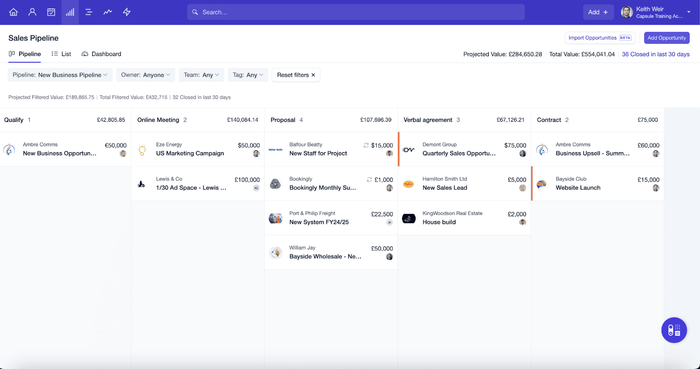
Analyze your sales process and note down the key milestones that every prospect goes through to become a customer, from lead generation to closing.
For example, the default pipeline in Capsule is:
- New
- Qualified
- Meeting
- Proposal
- Negotiation
- Contract
Step 2: Customize your pipeline
Adding cross-sell or upsells usually doesn’t require massive changes to your sales pipeline; it’s more about ensuring that you’re a) understanding the customer’s needs and b) making an additional offer that meets those needs. Customizing your pipeline with this in mind means that reps are more likely to make those offers in a way that feels natural to the customer.
Consider tailoring your pipeline to reflect different pathways for your various products or services. For instance, customers using a basic service may see a different upsell path compared to those already on a premium service. You could also modify your pipeline stages based on whether or not the customer is likely to be interested in an upsell or cross-sell, based on engagement metrics or direct customer feedback.
In some cases, where the sales process is largely the same for all customers, you might be able to use the same pipeline with tags for segmentation. However, if there are significant differences or you want to create a dedicated upsell/cross-sell pipeline, create multiple pipelines to accurately capture the differences (available in Capsule on Growth plans and higher).
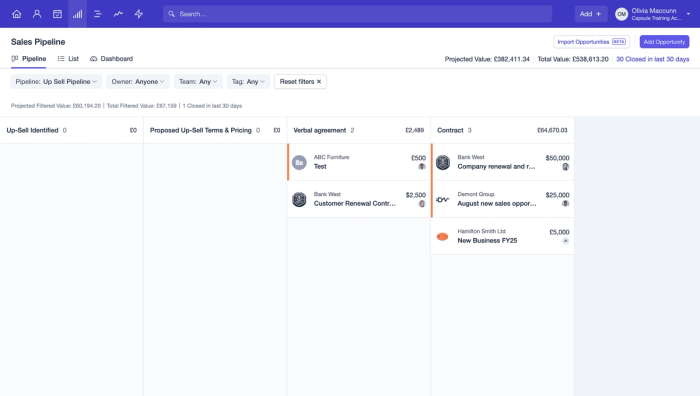
Step 3: Develop clear criteria for each stages
Everybody on your sales team should know precisely when to move a prospect onto the next stage in your pipeline. Having documented criteria for moving leads through the sales pipeline prevents deals from stalling and ensures reps know exactly when to make any additional offers.
Identify specific actions that trigger a move to the next stage, such as a customer expressing interest in learning more about a product after receiving a targeted communication. For example, your proposal stage might include multiple personalized proposals, highlighting the benefits and value of your upsell or cross-sell options.
This clarity enables you to ensure every potential customer sees the best possible offers, increasing the value to both you and the customer.
Step 4: All releant tasks and automation
Very often, the best way to increase your upsells and cross-sells is by ensuring your sales teams make those offers. By creating a standardized to-do list for your reps to follow, they’re more likely to make cross-sell/upsell offers at the right time.
You can further streamline the process with workflow automation, offloading all the repetitive tasks that suck up your reps’ time or may otherwise be forgotten. For example, you can automate follow-up emails for a set amount of time after the initial sale, checking that the customer is happy with their purchase and recommending complementary offers.
Use your CRM’s automation features to handle these activities, freeing up your team to focus on sales. Capsule’s Tracks feature provides sales reps with a templated task list, showing what needs to be done for each stage (such as reviewing customer engagement or highlighting the benefits of an upgrade).
You can then use automation (available on Growth plans and higher) to add the relevant track when the defined criteria are met, such as a prospect moving to the proposal stage in the pipeline.
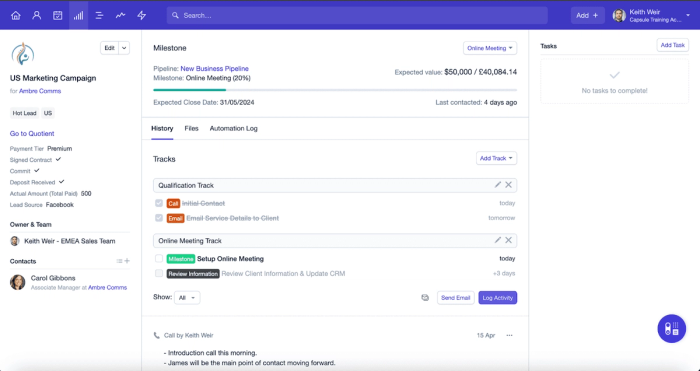
Step 5: Monitor and optimize pipeline performance
By using a set sales pipeline for your sales organization, you can review your team’s sales performance at different points in the process and identify where cross-sells and/or upsells are more effective. Use your CRM’s analytics and reporting features to track sales metrics throughout the pipeline, then use that data to optimize your sales process.
Pay particular attention to specific metrics such as conversion rates from initial offer to acceptance, customer feedback on the offers and overall customer satisfaction post-purchase.
As well as giving you ways to improve your overall sales process, you can also use your pipeline to spot individual leads and prospects who might be interested in some of your other solutions. One of Capsule’s popular contact management features is dynamic contact lists based on your chosen criteria.
For example, you can filter for contacts where they’ve purchased in the last week and given positive feedback. You can then follow up with those prospects to see if they’d benefit from an upgraded product or service.
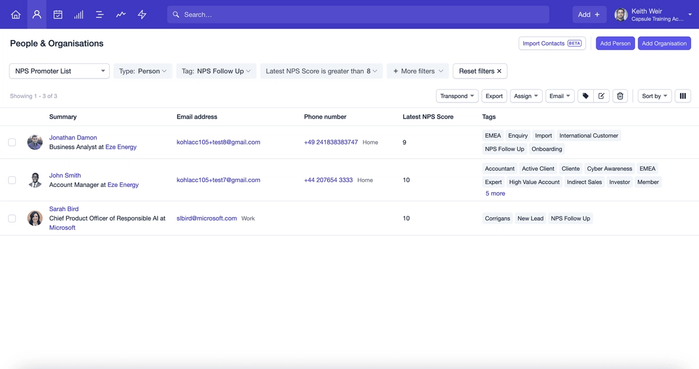
Creating more value for you and your customers
As businesses look for new and innovative ways to boost revenue, most of them ignore the vast potential within their existing customer base. Simply reaching out to current customers and asking how you can help will almost certainly result in more sales.
However, to get the best results, ensure you’re making relevant offers at the right time. When you focus on what will benefit the customer most, the upsells and cross-sells will follow. With a tailored sales pipeline, you can standardize the process, giving your sales team everything they need to make compelling offers that help your customers and increase your bottom line.
Discover how a CRM can help your business with cross-sells and upsells. Enjoy Capsule’s free starter package or start a 14-day free trial and see how Capsule’s features can help you create more relevant offers that your customers love.
